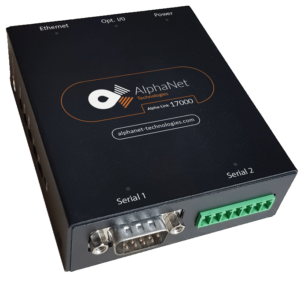The AlphaNet AT17000-MMt Gateway Converter Series stands at the forefront of industrial connectivity, and at its heart lies the powerful Modbus TCP network protocol. In this article, we’ll explore the ins and outs of the Modbus TCP network, its significance in the AlphaNet AT17000-MMt Gateway Converter Series, and how it revolutionizes industrial communication.
Unveiling Modbus TCP Network
The Foundation of Industrial Communication
Modbus TCP, a variant of the Modbus protocol, is a widely adopted communication protocol in industrial automation and control systems. It’s specifically designed for Ethernet-based networks, making it suitable for modern industrial applications. Let’s delve into the key aspects of Modbus TCP network:
1. Ethernet-Based Communication
Modbus TCP leverages the Ethernet protocol for communication. Ethernet is known for its speed, reliability, and widespread availability in industrial settings, making it an ideal choice for connecting devices and systems.
2. Client-Server Architecture
Modbus TCP follows a client-server architecture, where devices known as clients initiate requests, and devices known as servers respond to those requests. This architecture facilitates centralized control and monitoring of multiple devices from a single point.
3. IP Addressing
Devices in a Modbus TCP network are assigned unique IP addresses, enabling them to identify and communicate with each other over the Ethernet network. IP addressing ensures data packets are directed to the correct destination.
4. Port Numbers
Modbus TCP uses port numbers to distinguish between different services or functions. The standard port number for Modbus TCP communication is 502, but it can be configured to use other port numbers as well.
5. Real-Time Data Exchange
One of the strengths of Modbus TCP is its real-time data exchange capability. It enables devices to share data in real time, making it crucial for applications where timely information is essential.
The Role of Modbus TCP in the AT17000-MMt Gateway Converter Series
A Seamless Integration
The AlphaNet AT17000-MMt Gateway Converter Series harnesses the power of Modbus TCP to enable seamless integration of Modbus RTU/ASCII devices into Ethernet-based networks. Here’s how Modbus TCP plays a pivotal role in this series:
1. Protocol Translation
The AT17000-MMt Gateway Converter Series excels in protocol translation. It translates Modbus RTU/ASCII commands and data into the Modbus TCP format and vice versa. This ensures that Modbus RTU/ASCII devices can communicate effectively with Modbus TCP devices on the same network.
2. Real-Time Data Exchange
Industrial operations demand real-time data for decision-making and control. The AT17000-MMt Gateway Converter Series ensures that data is exchanged in real time, providing up-to-the-minute information about your industrial processes. This real-time capability enhances your ability to monitor, analyze, and respond to changes promptly.
3. Remote Monitoring and Control
With the AT17000-MMt Gateway Converter Series, you gain the ability to monitor and control your Modbus RTU/ASCII devices remotely. This feature is invaluable for troubleshooting, making adjustments, and optimizing your industrial processes without the need for physical presence at the device location. It saves time and resources, making your operations more efficient.
4. Device Integration
Whether you have legacy Modbus RTU/ASCII devices or modern Modbus TCP devices, the AT17000-MMt Gateway Converter Series seamlessly integrates them into your industrial network. This flexibility is invaluable for maintaining and upgrading your network infrastructure as needed.
5. Compatibility
Modbus TCP compatibility ensures that the AT17000-MMt Gateway Converter Series can seamlessly communicate with a wide range of industrial devices and systems. It simplifies the process of integrating the gateway converters into your existing network.
Advantages of Modbus TCP Network in Industrial Communication
Enhancing Industrial Connectivity
The Modbus TCP network offers several advantages that enhance industrial communication and connectivity:
1. Speed and Efficiency
Ethernet-based Modbus TCP networks offer high-speed communication, enabling quick data exchange between devices. This speed is crucial for applications that require rapid response times.
2. Widespread Adoption
Modbus TCP is widely adopted in the industrial automation sector, resulting in a large ecosystem of compatible devices and systems. This widespread adoption simplifies integration and ensures compatibility.
3. Scalability
Ethernet networks, including Modbus TCP, are highly scalable. You can easily add new devices and expand your network as your industrial operations grow.
4. Remote Accessibility
Modbus TCP networks support remote monitoring and control, allowing operators to manage industrial processes from anywhere with an internet connection. This remote accessibility is particularly valuable for troubleshooting and maintenance.
5. Data Security
Ethernet networks, when configured properly, can offer robust data security features, safeguarding sensitive industrial data from unauthorized access and cyber threats.
Conclusion: The Backbone of Industrial Connectivity
Modbus TCP in the AT17000-MMt Gateway Converter Series
In the world of industrial connectivity, Modbus TCP network plays a pivotal role, and it’s the beating heart of the AlphaNet AT17000-MMt Gateway Converter Series. By seamlessly bridging Modbus RTU/ASCII and Modbus TCP protocols, this series empowers industries to optimize efficiency, reduce costs, and adapt to evolving technological landscapes. Modbus TCP’s speed, efficiency, scalability, and compatibility ensure that the AT17000-MMt Gateway Converter Series is not just a gateway but the key to unlocking the full potential of industrial applications.
With its real-time data exchange, remote accessibility, and protocol translation capabilities, the AT17000-MMt Gateway Converter Series sets the standard for seamless integration and real-time data exchange in the industrial automation sector. It’s more than a gateway; it’s the backbone of industrial connectivity.


